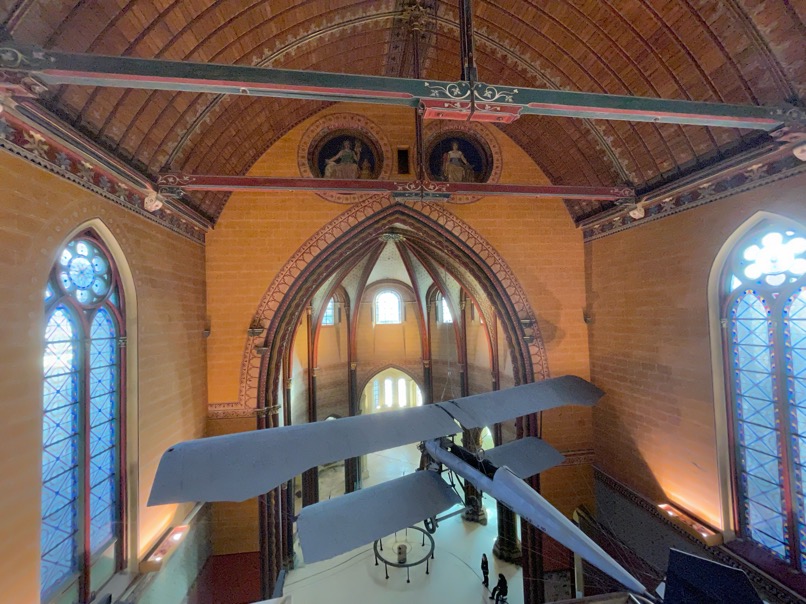The Museum of Arts and Crafts
The Musée des Arts et Métiers, located in the heart of Paris, is probably one of the oldest museums in the world dedicated to science and its techniques. The museum has nearly 80,000 objects and 15,000 drawings, of which only a small part is on display. Here, the visitor will be able to discover nearly 2,500 pieces, real historical objects, models, reconstructions, drawings that tell the history of techniques on 7 major themes: Scientific Instruments, Materials, Construction, Communication, Energy, Mechanics, Transport. As we can see, these themes remain very current and in line with the needs and developments of our time.
Here we will talk mainly about the Transport section, more particularly the cars presented, without omitting the other means of transport.
My Favorites
The collections of the Musee des Arts et Métiers contain some marvels and many unique machines. My favorites not to be missed (in the theme Transport):
- The fardier of Cugnot, still the 1st “auto-mobile” machine in the world
- The former church of the Priory, which today houses a few planes and a spectacular structure exhibiting cars on several floors
- The F1 Renault RE 40 Turbo
History of the museum
The Conservatoire National des Arts et Métiers (National Conservatory of Arts and Crafts) was created in 1794 by a law of the Convention (political regime after the French revolution), with the aim of preserving technical and industrial inventions, but above all to present them "in motion" in order to educate and thus encourage scientific progress. Several existing collections were brought together, and the Conservatoire moved in 1798 to the former Priory of Saint-Martin-des-Champs, which it still occupies today. A mechanical workshop, a draughtsmen's office and a library were quickly established, and the collections classified in the galleries that opened in 1802. The musée des Arts et Métiers is therefore installed in what was an important priory until the French Revolution. The collections were regularly enriched according to inventions, in order to meet the objective of teaching and education. The Conservatoire thus becomes a full-fledged training institution, with the particularity of seeing the techniques at work, through the machines "in large", functional models or with the help of very detailed sketches and drawings. The buildings and the museum have undergone several evolutions since the creation, and even some name changes while keeping similar objectives. Over time, teaching and museum activities will separate, but the museum remains a branch of the Conservatoire National des Arts et Métier. Renamed musée des Arts et Métiers, it underwent a major renovation, both architectural and museographic, in the 1990s. The organization of the collections according to the themes dates from this renovation, allowing clearer and more informative visit routes.
The first rooms
The Transport section, like the other themes, presents many authentic vehicles, but also many scale models and drawings, especially for maritime and rail transport. An exceptional piece and one of the jewels of the collections of the Musée des Arts et Métiers, the Cugnot’s fardier is the first automotive machine ever made. The purpose of this machine was to facilitate the transport of artillery pieces, replacing the draft horses with a steam boiler that would operate the front drive wheel. The “prototype” was built, but the political disgrace of its promoters put an end to the project. It is now accepted that this authentic model on display at the museum was probably never really tested. But an exact scale 1 replica was built by the association “Le fardier de Cugnot”, in cooperation with the Musée des Arts et Métiers and thus made it possible to demonstrate that the machine was functional!
After the room of the fardier, a gallery presents some representatives of the beginnings of the first “real” automobiles at the end of the 19th century, with a Serpollet steam tricycle and a Peugeot quadricycle. Unique pieces because obviously we were still far from industrial productions, they show the filiation with the horse-drawn carriage, but also that the choices of motorization are not yet finalized. A Ford T is also on display, but although it comes from the first mass production, this model is unique in its configuration. Indeed, it was rebuilt in the 1950s at the request of the Musée des Arts et Métiers, but only with original pieces. This Ford T is therefore both unique and authentic! In this gallery, some cycles and tricycles present some examples of the solutions that were used before arriving at the shape of the bikes we know.






The nave of the church
The rest of the visit takes you to the old church of the priory which has been preserved, even if it has also undergone evolutions and restorations. The vault of the nave has been covered with varnished and colored paneling. Symbol of the reallocation of the place, the figures of Agriculture and Industry sit above the broken arch that ensures the junction between the nave and the choir. The latter has retained its carved medieval capitals and a certain sobriety. The whole creates a very original and unusual setting for the visitor. Before you get interested in cars, stop in the choir to relive the experience of Foucault’s pendulum (the original is in the Pantheon) which demonstrates the rotation of the earth.
In the nave, the Obéissante (the Obedient) built in 1873 by Amédée Bollée welcomes you. It is a steam omnibus, capable of carrying 12 passengers at a remarkable speed (for the time) of 30km/h (18mph) and even peaking at 40km/h (24mph). The machine was (says the history) driven at your fingertips ! In 1875, Amédée Bollée covered the 230 kilometers (142 miles) between Le Mans and Paris in 18 hours, a remarkable performance if we consider the size of the vehicle, the state of technology and especially the roads at that time!
Next to it, a Citroën C6G from 1931 is cut in 2 lengthwise, showing the structure of its body and mechanical components. This model entered the collections as it is, because it was used by Citroën to demonstrate the solidity of its structure and the innovations it presented.



A ramp leads to the 1st level of an impressive metal structure on which the cars are exposed on several floors. A walkway and stairs allow to circulate in the structure where the cars rest on beams. They can be seen from all angles, including from below and above. We start with a Renault RE40 Formula 1. Driven by Alain Prost in the 1983 World Championship, it is the 1st Renault chassis entirely made of carbon fiber, still powered by the 1500cc turbo V6. We then plunge back into history, end of the 19th century, beginning of the 20th. The Panhard and Levassor M2E from 1896 looks very much like a small horse cab from which the stretchers of carriage would have been removed. We see that then the shapes move away from the coaches or cycles, even if the comfort remains rudimentary. It is estimated that there were in France several hundred manufacturers at the beginning of the 20th century, and the proposals are numerous, whether by motorization, style, or manufacturing techniques. Thus, this opposite De Dion Bouton of 1899, 4 seats in “living room”. Not necessarily ideal for the driver, but that did not prevent De Dion Bouton from manufacturing 3,000 units, becoming the 1st manufacturer in the world at that time!



Another curiosity with this Peugeot from 1909, officially called “Grand Tourism”. As we can see, the notion of Grand Tourism has changed a lot in a century. Even more surprising, the Hélica built in 1921 by the engineer Leyat and moving with a propeller, like an airplane. As has been said, this era was full of innovations and sometimes very strange attempts. More down to earth, utility and pick-up before the hour, the Panhard and Levassor M2F of Professor d’Arsonval, specially adapted in 1898 for his experiments and the circulation in his property. With the Hispano-Suiza K6 of 1935, we make a leap forward, in style, performance and luxury. This model, in this Coupé de ville version, represents the ultimate luxury in these interwar years. Germany was at that time the other major car producing country, represented here by an 1898 Benz.




Do not forget to look up at the vault of the nave, from which hang some aviation pioneers of the early20th century.
The photos on this page belong to Automobile-Museums, no use or reproduction is allowed without written permission from the owner.


